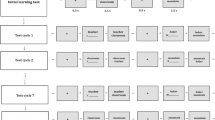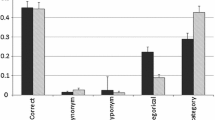Summary
Subjects had to learn lists of noun pairs and verb pairs. They were informed in advance about the test types and were tested for free recall (FR) and cued recall (CR). Three classes of encoding instructions were used: standard learning instructions, item-specific enactment instructions (to perform the denoted action of the verb or a typical action for the noun, and to do the same plus finding separate goals for the two elements of each pair), and enactment instructions that were completed by explicit instructions to integrate the word pairs (find a common goal, and find a common goal plus rating your success). There was no effect of encoding instructions on FR of nouns. There was a better FR under all enactment instructions than under standard instructions for verbs. CR decreased after item-specific enactment instructions, in contrast with standard learning instructions, but more for nouns than for verbs. CR increased after the instructions to integrate the pairs, in contrast with item-specific enactment instructions, but more for nouns than for verbs. It was concluded that enactment provides excellent item-specific information that can hardly be enhanced further, and that the item-specific information provided by concrete nouns is fundamentally good and is difficult to enhance by enactment. It is further assumed that enactment not only provides excellent item-specific information, but also hinders pair integration. Therefore, CR decreases after enactment. This decrease can only be overcome when subjects actively try to integrate the word pairs.
Similar content being viewed by others
References
Bäckman, L., Nilsson, L.-G., & Chalom, D. (1986). New evidence on the nature of the encoding of action events.Memory & Cognition, 14, 339–346.
Begg, I. (1978). Imagery and organization in memory: Instructional effects.Memory & Cognition, 6, 174–183.
Bower, G. H. (1972). Mental imagery and associative learning. In L. W. Gregg (Ed.),Cognition in learning and memory. New York: Wiley.
Clark, H. H. (1966). The prediction of recall patterns in simple active sentences.Journal of Verbal Learning and Verbal Behavior, 29, 529–533.
Cohen, R. L. (1981). On the generality of some memory laws.Scandinavian Journal of Psychology, 22, 267–281.
Cohen, R. L. (1983). The effect of encoding variables on the free recall of words and action events.Memory & Cognition, 11, 575–582.
Einstein, G. O., & Hunt, R. R. (1980). Levels of processing and organization: Additive effects of individual item and relational processing.Journal of Experimental Psychology: Human Learning and Memory, 6,588–598.
Engelkamp, J. (1986). Nouns and verbs in paired-associate learning: Instructional effects.Psychological Research, 48, 153–159.
Engelkamp, J. (1988). Nouns and verbs in the mental lexicon. In W. Millen & R. Schulz (Eds.),Understanding the lexicon: Meaning, sense and world knowledge in lexical semantics. Tübingen: Niemeyer.
Engelkamp, J. (1989). Memory for performed and imaged noun pairs and verb pairs. A comment on Tore Helstrup.Psychological Research, 50, 241–242.
Engelkamp, J., Zimmer, H. D., & Denis, M. (1989). Paired associate learning of action verbs with visual- or motor-imaginal encoding instructions.Psychological Research, 50, 257–263.
Engelkamp, J., Zimmer, H. D., & Mohr, G. (1990). Differential memory effects of concrete nouns and action verbs.Zeitschrift für Psychologie, 198, 189–216.
Gentner, D. (1981). Some interesting differences between verbs and nouns.Cognition and Brain Theory, 4, 161–178.
Gentner, D. (1982). Verb semantic structures in memory for sentences. Evidence for componential representation.Cognitive Psychology, 13,56–84.
Graesser, A. C., Hopkinson, P. L., & Schmid, Ch. (1987). Differences in interconcept organization between nouns and verbs.Journal of Memory and Language, 26, 242–253.
Helstrup, T. (1987). One, two, or three memories? A problem-solving approach to memory for performed acts.Acta Psychologica, 66, 37–68.
Helstrup, T. (1989). Memory for performed and imaged noun pairs and verb pairs.Psychological Research, 50, 237–240.
Hirshman, E., & Bjork, R. A. (1988). The generation effect: Support for a two-factor theory.Journal of Experimental Psychology: Learning, Memory, and Cognition, 14, 484–494.
Hunt, R. R., & Einstein, G. O. (1981). Relational and item-specific information in memory.Journal of Verbal Learning and Verbal Behavior, 20, 497–514.
Huttenlocher, J., & Lui, P. (1979). The semantic organization of simple nouns and verbs.Journal of Verbal Learning and Verbal Behavior, 18, 141–162.
Marschark, M., & Hunt, R. R. (1989). A reexamination of the role of imagery in learning and memory.Journal of Experimental Psychology: Learning, Memory, and Cognition, 15, 710–720.
McDaniel, M. A., Einstein, G. O., Dunay, P. K., & Cobb, R. E. (1986). Encoding difficulty and memory: Toward a unifying theory.Journal of Memory & Language, 25,645–656.
McDaniel, M. A., Einstein, G. O., & Lollis, T. (1988 a). Qualitative and quantitative considerations in encoding difficulty effect.Memory & Cognition, 16, 8–14.
McDaniel, M. A., Waddill, P. J., & Einstein, G. O. (1988b). A contextual account of the generation effect: a three-factor theory.Journal of Memory & Language, 27,521–536.
Mohr, G., Engelkamp, J., & Zimmer, H. D. (1989). Recall and recognition of self-performed acts.Psychological Research, 51, 181–187.
Nilsson, L. G., & Cohen, R. L. (1988). Enrichment and generation in the recall of enacted and non-enacted instructions. In M. M. Gruneberg, P. E. Morris, & R. N. Sykes (Eds.),Practical aspects of memory: Current research and issues (pp. 427–432). Chichester: John Wiley & Sons.
Raaijmakers, J. G. W., & Shiffrin, R. M. (1980). SAM: A theory of probabilistic search of associative memory. In G. H. Bower (Ed.),The psychology of learning and motivation (Vol. 14). New York: Academic Press.
Wearing, A. J. (1970). The storage of complex sentences.Journal of Verbal Learning and Verbal Behavior, 9, 21–29.
Zimmer, H. D. (1984).Enkodierung, Rekodierung, Retrieval und die Aktivation motorischer Programme (Arbeiten der FR Psychologie Nr. 91). Saarbrücken: Universität des Saarlandes.
Zimmer, H. D. (1990). On the importance of item-specific and relational information for memory of subject-performed tasks. Paper given at the 4th Conference of the ESOP at Como (Italy).
Zimmer, H. D., & Engelkamp, J. (1989). Does motor encoding enhance relational information?Psychological Research, 51, 158–167.
Author information
Authors and Affiliations
Rights and permissions
About this article
Cite this article
Engelkamp, J., Mohr, G. & Zimmer, H.D. Pair-relational encoding of performed nouns and verbs. Psychol. Res 53, 232–239 (1991). https://doi.org/10.1007/BF00941392
Issue Date:
DOI: https://doi.org/10.1007/BF00941392




